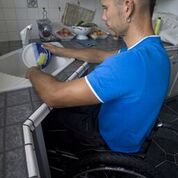Written by: Jason Biddle, The Helping Home
The first part of this series detailed suggestions for making food preparation easier for wheelchair users. You can read more about that here. Part two listed kitchen modifications that help with cooking. If you haven’t checked out part two you can view it here.
This third and final part of the series examines ways to make the kitchen wheelchair accessible for washing dishes.
Roll-under Sink
Converting a standard sink base cabinet into a roll-under sink is one of the more straightforward modifications that offers a big impact. Have a cabinet maker remove the base cabinet doors, cut out the non-supportive cabinet bottom along with the toe-kick, and add a wooden apron to keep the pipes hidden.
You may need a plumber to re-position the pipes to allow for maximum roll-under space. Also, if the cabinets were not installed over the existing flooring, then you may need to lay a small amount of flooring over the footprint where the sink base cabinet once occupied.
Dishwasher Drawer

Swap out your conventional dishwasher with a dishwasher drawer to avoid the bending involved in operating the door and reaching the bottom dish rack. Installation is easy since dishwasher drawers fit in the same opening as standard dishwashers, but you’ll need to decide the best way to use the now-open space below.
Some may prefer to add a second dishwasher drawer, but keep in mind that this lower unit may be just as difficult to access as the bottom rack of a standard dishwasher. The other option is to add a base cabinet drawer to create storage space below the dishwasher drawer. If you can get away with using one dishwasher drawer, then the additional cabinet may be the best route. Those who need more dishwashing capacity may opt for the stacked dishwasher drawers or even two top-level dishwasher drawers with base cabinets below, if the budget allows.
Pull-down Shelves
Putting clean dishes into cupboards may not be viable if the shelves are too tall. Bring upper kitchen cabinets within reach by replacing standard cabinet shelves with pull-down shelves. Pull-down shelving systems employ a pneumatic-powered mechanism to make lifting and lowering the shelves much easier. Many units even feature hardware that prevents sudden stops so items on the shelf don’t shift and fall.
For more information, check out this guide to learn about additional assistive technology solutions that help with washing dishes.
Financing Assistance
If you need help with financing and are enrolled in or qualify for Medicaid, then click here to learn if your state’s Medicaid program covers the cost of medically necessary home modifications.
For military service members, the Department of Veterans Affairs offers three different types of grants for medically necessary home modifications. Learn more about the Specially Adapted Housing (SAH) Grant and the Special Housing Adaptation (SHA) Grant here. And you can learn more about the Home Improvements and Structural Alterations (HISA) Grant here.
Also, there are other state-specific programs that provide financial assistance for home modifications, so it is worth taking the time to research what else is available.
Finally, Rebuilding Together is a national non-profit that helps retrofit homes to make them more accessible and user-friendly. You can check to see if there is a local affiliate by visiting the Rebuilding Together website.
Feedback
Are there any home modifications that you have found to make doing the dishes more accessible for wheelchair users? Do you know of other sources of funding to help finance home modifications? If so, we’d love to hear your input!




